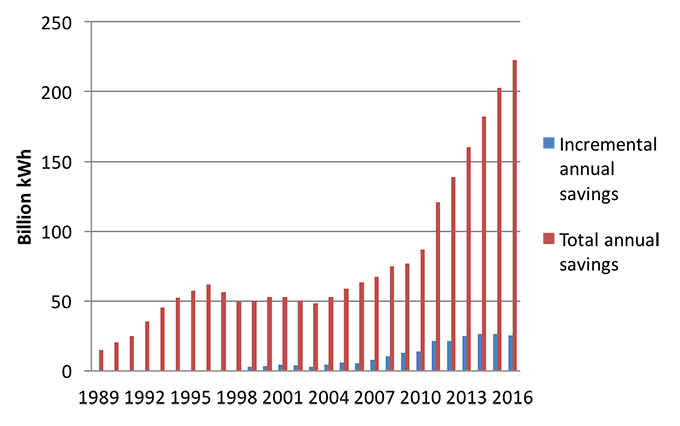The past year has been eventful for energy efficiency, bringing progress in some areas and backsliding in others. We have made significant progress and are poised for more, particularly at the state and city levels. Meanwhile, we face substantial challenges at the federal level, and will continue to emphasize defense in 2018, while also working to develop new strategies for progress.
Given 2017, we have reasons to be optimistic about continued progress in energy efficiency:
Energy-saving technologies and practices advance. LED bulbs accounted for about 30% of screw-in “A-line” lamp sales in the first half of 2017 and smart thermostat sales increased about 19% per year according to one estimate.
Investments in energy efficiency continue to grow. The International Energy Agency estimates US efficiency investments of $41 billion in 2016, and total global investments of $231 billion, a 9% increase over the prior year (2017 figures are not yet available).
States move forward. They enacted new energy efficiency legislation in Colorado, Maryland and Nevada, and took steps to implement 2016 legislation in Illinois and Michigan. In Ohio, a moratorium on savings targets expired and utilities are proposing new programs.
Local governments became more active, including more than 300 that have pledged to meet the Paris climate change goals as part of the We Are Still In campaign. Several cities are establishing new building retrofit policies. For example, Mayor de Blasio of New York City announced plans to require major efficiency upgrades for 14,500 large, inefficient buildings. Likewise, 30 cities jointly informed vehicle manufacturers of their interest in purchasing 114,000 electric vehicles for their fleets.
Total savings from utility energy efficiency programs increase, with savings of more than 220 billion kWh in 2016 (the last year with data available), which is about 6% of 2016 electricity consumption (see figure below).
The new federal tax legislation increased the incentive to upgrade when existing equipment and roofs need repair. The bill, enacted in December, allows some new HVAC equipment and roofs to be immediately expensed, instead of depreciated over 39 years.
However, there are also potential roadblocks and challenges to keep in mind:
Efficiency gains from appliance standards are at risk. After affirming several new consensus appliance standards negotiated during the Obama administration (e.g., for pool pumps and for residential central air conditioners and heat pumps), further work on establishing new standards has ground to a halt. The last time this happened (during President George W. Bush’s first term), states and environmental groups successfully sued; the settlement set a schedule for the Department of Energy (DOE) to issue standards after President Barack Obama took office. In December, the administration put more than 20 statutorily-required appliance efficiency standard updates on hold indefinitely, in addition to opening a proceeding that could make it more difficult to update product efficiency standards. Other appliance standards developments will be discussed in a forthcoming blog post by Andrew deLaski.
Key federal efficiency programs are on the chopping block. Over the past year, the administration has proposed eliminating ENERGY STARÔ, rolling back vehicle fuel economy standards and the Clean Power Plan, in addition to proposing deep cuts to federal energy efficiency budgets. As of this writing none of these proposals have been adopted, but we expect some to advance in 2018.
Federal implementation efforts are also being scaled back, as a result of the current administration’s preference for “pre-commercial” research and development over implementation efforts.
The administration is working to weaken fuel economy and emissions standards for passenger vehicles and medium and heavy trucks. We have discussed these developments in prior blog posts (see here and here). We expect the administration to make additional regulatory proposals, but final rules and court challenges will extend into 2019 if not beyond.
Efficiency programs were challenged in several states, including a raid on energy efficiency funds in Connecticut to help balance the state budget.
The Path Forward
Looking into the new year, we will have both opportunities and challenges.
We see local and state policy as a substantial opportunity. The “We Are Still In” communities now need to identify, adopt, and implement policies to achieve these goals. Several states will be establishing new energy savings targets, undertaking integrated planning processes, and expanding programs in response to recent legislation. We are also hoping for additional efficiency progress in New Jersey and Virginia, where governors supportive of energy efficiency were recently elected. For example, both states are considering joining the Regional Greenhouse Gas Initiative.
With the pause on new federal efficiency standards, several states are considering new state efficiency standards. Likewise, California is expected to pursue light- and heavy-duty greenhouse gas emissions standards in 2018, and other states may choose to adopt the California standards.
We are primarily focused on preventing backsliding at the national level, while also developing a positive agenda. ACEEE and other organizations are pushing back against proposed budget cuts to efficiency programs at DOE and other federal agencies as well as Environmental Protection Agency programs such as ENERGY STAR, WaterSense and SmartWay. We expect to see modest budget cuts rather than the draconian cuts proposed by the administration. Final funding decisions are due by January 19.
We will support positive reforms, while opposing efforts to eliminate or weaken efficiency standards and programs. Congress is considering changes to efficiency laws that would weaken fuel economy and appliance standards, ENERGY STAR, and building energy codes. We are discussing more modest reforms to ENERGY STAR and appliance standards with those seeking changes, but we will oppose major changes that would reduce the impact of these programs.
New legislation generally needs 60 votes in the Senate, requiring some bipartisan support. Furthermore, the possibility that any legislation will be enacted shrinks as we move into the 2018 campaign. Still, smaller efficiency measures are in play in the Senate energy bill and other measures could be included in post-disaster federal rebuilding efforts or an infrastructure package (Senate Majority Leader McConnell has indicated that infrastructure could be on the Congressional agenda).
Our Resolutions for 2018
All in all, efficiency is making progress at the local and state levels, but strong headwinds remain at the national level. Minimizing slippage at the national level while expanding state and local policies and programs will be critical. Through our research and outreach, ACEEE will continue to tout the benefits of energy efficiency for a strong US economy, and will work to ensure that American families and businesses continue to see the greatest energy efficiency benefits possible.



